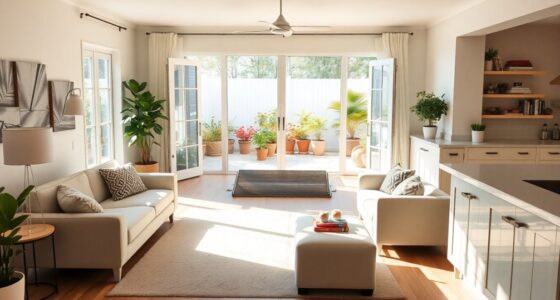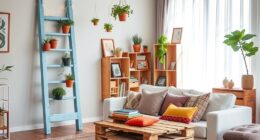Accessible furniture and fixtures are essential for making spaces comfortable and functional for everyone, especially those with mobility challenges. They're designed with features like adjustable heights and ample knee space, adhering to ADA standards. While choices can be limited and prices high, brands like Pottery Barn, IKEA, and Target are innovating to offer stylish options. Community feedback plays a significant role in shaping these designs. Discover more about the future trends and brands making a difference in accessibility.
Key Takeaways
- Accessible furniture ensures comfort for individuals with mobility challenges, featuring adjustable heights and ADA-compliant dimensions for wheelchair users.
- Limited options in physical stores often leave consumers uninformed about accessible furniture features and specifications.
- Mainstream brands like Pottery Barn and IKEA are innovating by creating aesthetically pleasing, ergonomic furniture solutions that prioritize accessibility.
- Collaborations with designers and community feedback drive the development of user-friendly adaptive furnishings tailored to diverse needs.
- Future trends focus on inclusivity and adaptability in furniture design, ensuring aesthetics do not compromise functionality for individuals with varying physical capabilities.
The Importance of Accessible Furniture
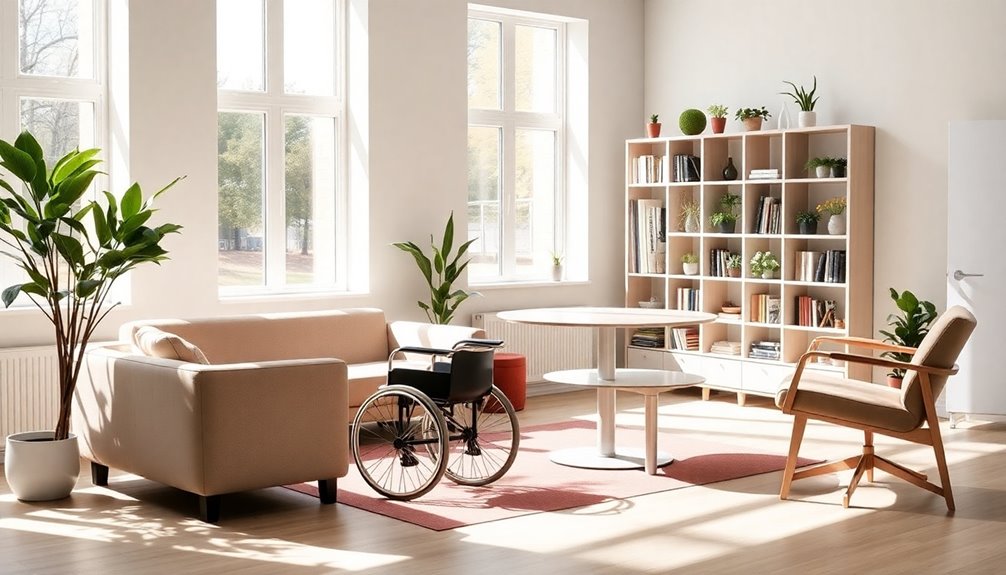
Accessible furniture is essential because it guarantees everyone, regardless of their mobility challenges, can enjoy comfortable and functional spaces.
Designed to meet the needs of individuals with disabilities, it features adjustable heights and specific dimensions that accommodate wheelchair users. According to the Disabilities ACT (ADA), furniture should provide a minimum of 25 inches of knee space and at least 30 inches of width clearance for ideal accessibility.
Companies like Pottery Barn and IKEA are leading the charge by reimagining over 150 products, marrying style with functionality.
By actively seeking feedback from communities, manufacturers can better understand specific challenges and create designs that enhance the user experience.
When accessible furniture becomes a priority, inclusivity in design truly flourishes.
Current Challenges in Accessible Design

Despite the growing awareness around the need for accessible design, significant challenges remain that hinder progress. You might find your options for accessible furniture limited in physical stores, pushing you to rely on online shopping without the ability to test compatibility. Exploring available choices requires specific knowledge that isn't always easy to find. High costs due to monopolistic pricing further complicate your search, while many products lack aesthetic appeal, resembling medical aids rather than stylish designs. Here's a quick overview of some challenges:
| Challenge | Description |
|---|---|
| Limited Options | Few physical stores carry accessible furniture. |
| Knowledge Gap | Consumers often lack info on features. |
| High Costs | Prices are inflated due to limited supply. |
| Aesthetic Appeal | Many items don't meet contemporary design standards. |
Accessible design should align with the Disabilities ACT (ADA) and be more affordable for everyone.
Innovations From Mainstream Brands
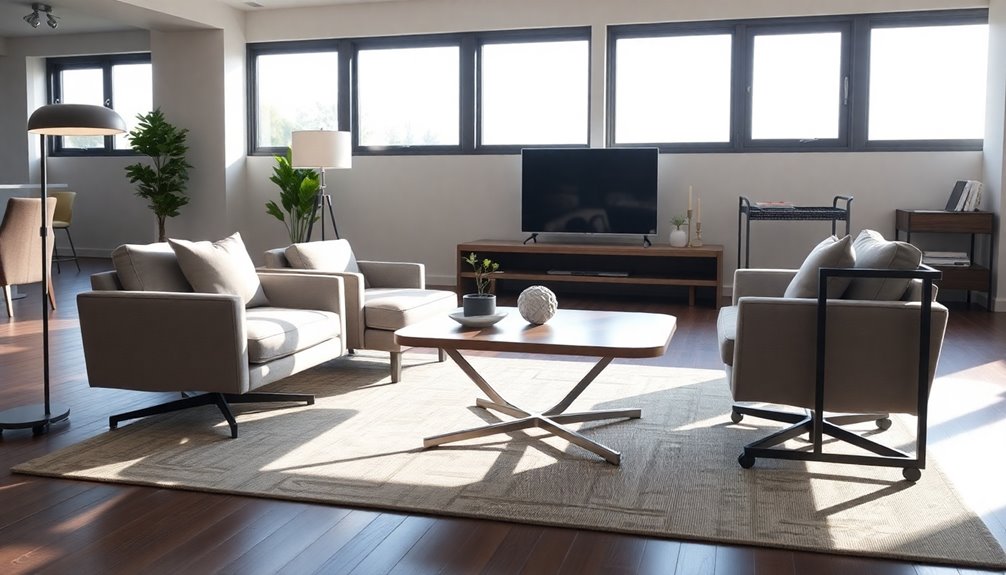
Mainstream brands are stepping up their game by embracing design inclusivity trends that cater to everyone.
You'll find innovative ergonomic furniture solutions that not only enhance comfort but also promote accessibility.
Plus, collaborations with talented designers are ensuring these products meet the diverse needs of users like you.
Design Inclusivity Trends
As brands recognize the importance of inclusivity, they've begun reimagining furniture and fixtures to meet the diverse needs of consumers.
In 2023, Pottery Barn launched over 150 accessible products, including power lift armchairs and adjustable mirrors.
IKEA's OMTÄNKSAM range, developed with ergonomists, enhances comfort and accessibility, while their ThisAbles initiative offers free 3D printable add-ons to modify furniture for better usability.
Target's Design For All Initiative, ongoing since 1997, continues to evolve with designer Michael Graves, focusing on universally accessible items.
With mainstream brands increasingly introducing new product lines centered on accessibility, you'll find more ergonomic and user-friendly options that enhance functionality across diverse user needs.
This trend marks a significant shift toward inclusive design in the furniture industry.
Ergonomic Furniture Solutions
With the push for inclusivity in furniture design, brands are stepping up their game in ergonomic solutions that cater to a wide array of needs.
Here are some exciting innovations you might find interesting:
- Pottery Barn launched over 150 reimagined products in 2023, enhancing accessibility for all users.
- IKEA's OMTÄNKSAM line is designed with ergonomists to boost comfort, ensuring thoughtful design for varying abilities.
- Target's Design For All Initiative focuses on universal design, making sure their products serve a diverse range of users, including those with disabilities.
These developments indicate a promising trend towards accessible ergonomic furniture, driven by consumer feedback and the commitment of mainstream brands to create inclusive environments.
Collaborations With Designers
In a bid to enhance accessibility, furniture brands are increasingly partnering with designers who specialize in inclusive solutions.
For instance, Pottery Barn launched over 150 reimagined products in 2023, including power lift armchairs and adjustable mirrors, focusing on accessible design.
Similarly, IKEA's OMTÄNKSAM range, developed with ergonomists, emphasizes comfort while ThisAbles offers free 3D printable add-ons for existing furniture.
Target's Design For All Initiative has been collaborating with designer Michael Graves since 1997 to create inclusive household items.
These collaborations reflect a market shift towards ergonomic, user-friendly options driven by consumer feedback.
Brands recognize the importance of engaging with communities to tackle specific accessibility challenges, ensuring that furniture is both functional and aesthetically pleasing.
Pottery Barn's Accessible Home Range

Pottery Barn's Accessible Home Range, launched in 2023, showcases over 150 reimagined best-sellers that prioritize inclusivity and functionality for diverse needs.
This innovative collection reflects a growing trend in the furniture industry and responds to consumer demand for stylish yet practical options.
Here are three standout features:
- Power Lift Armchairs: Designed for ease of use, these chairs provide support for individuals with mobility challenges.
- Adjustable Mirrors: These mirrors cater to various heights and abilities, enhancing accessibility in any space.
- Community Engagement: Pottery Barn actively collaborates with communities to gather feedback, ensuring their products address real accessibility challenges.
With this range, you can create a beautiful home that truly accommodates everyone's needs.
IKEA's OMTÄNKSAM and ThisAbles Initiatives

As the push for accessible design continues, IKEA's OMTÄNKSAM and ThisAbles initiatives stand out as exemplary efforts in the furniture industry.
Launched in 2020, OMTÄNKSAM was developed with ergonomists to enhance comfort and accessibility in everyday furniture. This range specifically supports individuals with limited mobility, creating a more inclusive living environment.
Meanwhile, ThisAbles offers free 3D printable add-ons that improve accessibility for existing furniture, allowing you to customize your space easily.
Both initiatives showcase IKEA's dedication to functional, user-friendly designs that cater to diverse needs. By collaborating with the community for feedback, IKEA prioritizes accessibility without sacrificing style or functionality, making it easier for everyone to enjoy their living spaces.
Target's Design For All Initiative
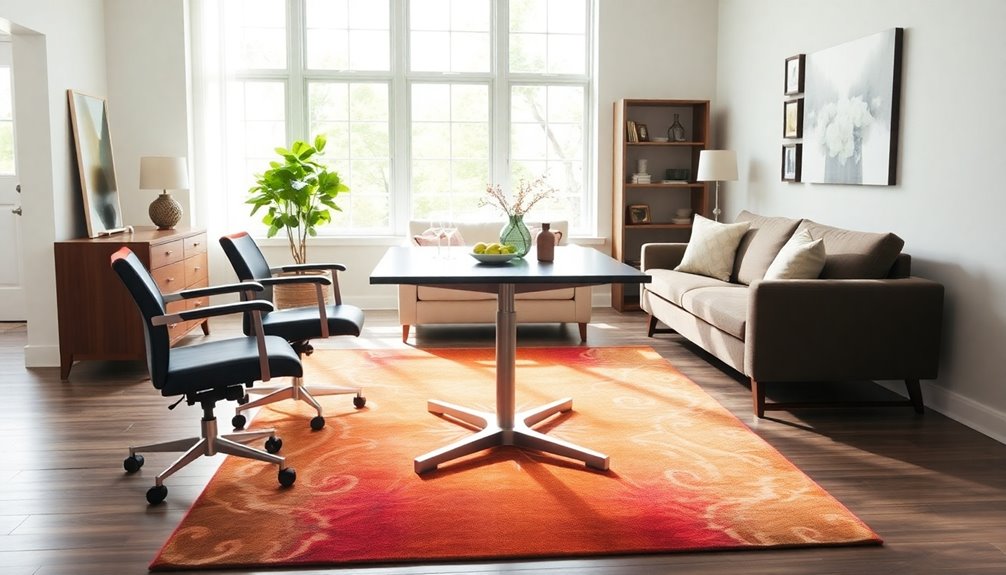
Target's Design For All Initiative shows how universal design principles can make furniture accessible for everyone.
By focusing on inclusive product development, you'll find that their items aren't only functional but also stylish.
This commitment helps guarantee that all customers can enjoy a seamless shopping experience.
Universal Design Principles
While many companies focus solely on aesthetics, Target's Design For All Initiative prioritizes universal design principles to guarantee that furniture and fixtures are accessible to everyone, regardless of ability. This commitment leads to innovative designs that enhance everyday living.
Here are three key aspects of universal design principles:
- Inclusivity: Target integrates consumer feedback, ensuring products meet diverse needs.
- Functionality: Their designs balance style and practicality, making sure they work for all users.
- Aesthetics: Accessible products don't compromise on looks; they align with current trends.
Inclusive Product Development
By focusing on inclusive product development, Target's Design For All Initiative aims to create furniture and household items that cater to diverse needs.
Launched in 1997, this initiative emphasizes accessibility through ongoing collaborations with designer Michael Graves, who specializes in accessible design.
You'll find a variety of adaptive furnishings that accommodate different physical capabilities, enhancing ease of use and comfort for everyone.
Target actively seeks your feedback, which helps them understand and tackle specific accessibility challenges you might face.
By prioritizing inclusivity in their product development, Target sets a standard in the retail furniture market, encouraging other brands to follow suit.
This initiative showcases Target's commitment to making everyday living accessible for all.
Community Engagement in Furniture Design
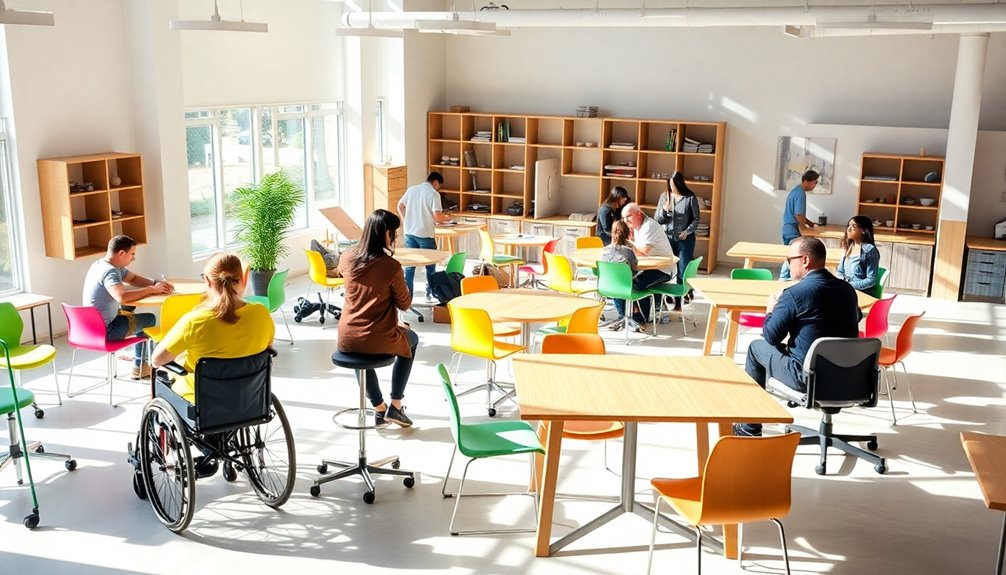
As companies recognize the importance of community feedback in furniture design, they're increasingly inviting consumers to share their accessibility needs.
This collaboration not only enhances designs but also leads to innovative solutions tailored for diverse users. Here's how your input makes a difference:
- Identifying Challenges: Your feedback helps brands understand specific difficulties faced by different communities.
- Driving Ergonomics: Engaging with you fosters the creation of more ergonomic and user-friendly furniture options.
- Shaping Adaptations: Companies are responding to rising expectations for accessible designs, adapting products based on your insights.
Collaborative initiatives, like IKEA's OMTÄNKSAM and Pottery Barn's revamped ranges, showcase the positive impact of community engagement, ensuring that accessible furniture meets real needs.
Your voice matters!
The Future of Accessible Furniture
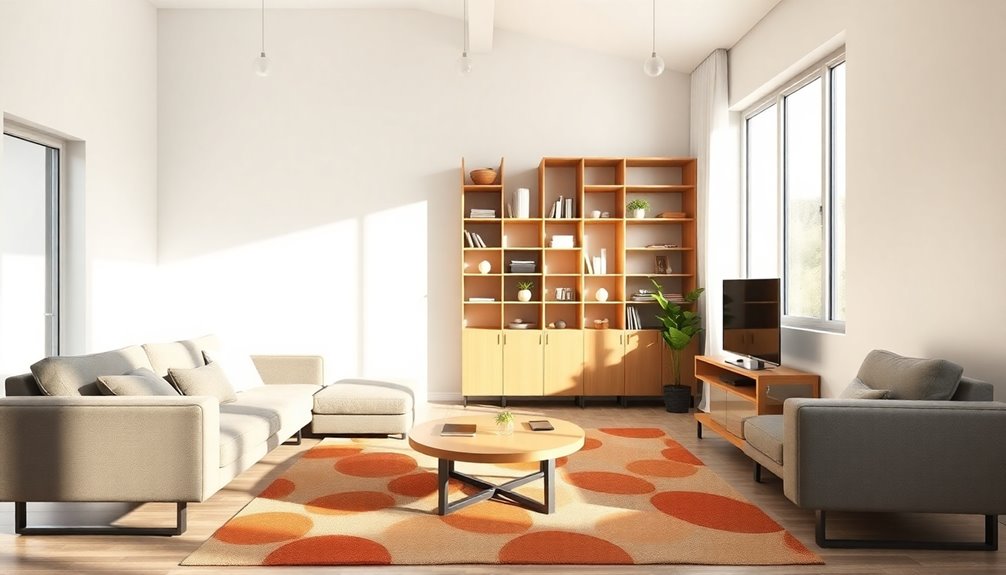
With the growing demand for accessible furniture, companies are reimagining their designs to meet diverse needs.
In 2023, brands like Pottery Barn adapted over 150 best-selling products to enhance accessibility.
IKEA's OMTÄNKSAM line, launched in 2020, showcases innovations developed with ergonomists, offering free 3D printable add-ons that improve comfort.
Consumer expectations are rising, with feedback from various communities driving adaptations and innovations in furniture design.
Target's Design For All Initiative emphasizes universality, fostering collaborations that produce inclusive products.
As awareness of accessibility grows, the market shifts towards more ergonomic, user-friendly options, ensuring that everyone can enjoy functional and stylish living spaces. Primitive weapons can also inspire creative adaptations in furniture design, promoting sustainability and self-reliance.
The future of accessible furniture looks bright, with continued focus on inclusivity and adaptability.
Frequently Asked Questions
What Are Examples of Furniture and Fixtures?
When you think about furniture and fixtures, consider items like tables, chairs, and shelves.
You've got couches and armchairs for comfortable seating, plus desks for work or study.
Don't forget about cabinets and bookcases for storage, or lighting fixtures like lamps and sconces to brighten your space.
Each piece contributes to your home's functionality and aesthetic, making it both inviting and practical for everyday use.
What Is Considered Furniture and Fixtures in Accounting?
In accounting, furniture and fixtures are tangible assets that you can see and use, but they aren't permanently attached to your building.
They include items like desks, chairs, tables, and cabinets for furniture, while fixtures might be lighting and shelving that are affixed to the property.
You'll need to capitalize their costs and depreciate them over a useful life, usually between 5 to 15 years, which helps assess your company's financial health.
What Category Is Furniture and Fixtures?
Furniture and fixtures fall under the category of durable goods. These items are essential for both residential and commercial spaces, designed for long-term use.
You'll find everything from chairs and tables to desks and shelving in this category. They're meant to enhance functionality and comfort in any environment.
When you invest in these products, you're not just buying items; you're choosing quality items that can serve you well for years to come.
What Is Furniture for Differently Abled Persons?
Furniture for differently abled persons is designed to meet specific needs, enhancing comfort and usability.
You'll find features like adjustable heights and wheelchair-friendly designs, allowing for greater accessibility in everyday life.
These pieces often include ergonomic considerations, ensuring they accommodate various physical requirements.
The market now offers stylish options that fit modern aesthetics, proving that functional furniture can also be visually appealing.
You'll discover a wide range of adaptive seating and tables tailored for inclusivity.
Conclusion
As you explore the world of accessible furniture, it's clear that inclusivity is becoming a priority for many brands. By embracing innovative designs and community input, companies like Pottery Barn, IKEA, and Target are making strides toward a more accessible future. You have the power to advocate for these changes and choose products that not only fit your needs but also promote a more inclusive environment for everyone. Together, we can make accessible living a reality.




